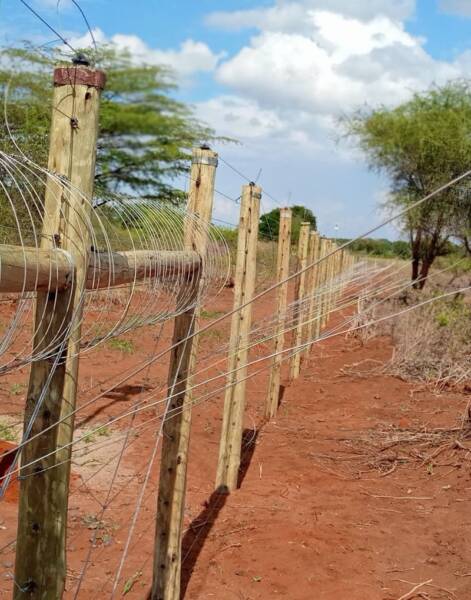Kenya is known for its vast and diverse wildlife, but with human population growth, wildlife habitats have been significantly reduced, and the number of wildlife species has been declining. To combat this, wildlife conservancy fences have been erected in various parts of the country to help conserve and protect wildlife.
Wildlife conservancy fences are physical barriers erected around protected areas such as national parks, game reserves, and conservancies to prevent human-wildlife conflicts, protect wildlife from poaching, and reduce habitat fragmentation. These fences not only protect the wildlife but also offer a chance to restore degraded habitats, improve wildlife populations, and promote eco-tourism.
One example of a wildlife conservancy fence in Kenya is the Aberdare Fence. The Aberdare Fence is a 400-kilometer electric fence that encloses Aberdare National Park in central Kenya. The fence has significantly reduced human-wildlife conflicts, especially between elephants and farmers living near the park. The fence has also enabled the restoration of degraded habitats and has improved the population of endangered species. Some of the wildlife whose population has increased include the bongo, mountain reedbuck, and the giant forest hog.
Another example of a wildlife conservancy fence is the Rhino Ark fence. The Rhino Ark fence is a 400-kilometer electric fence that encloses the Aberdare Range in central Kenya. The fence was built to protect the mountain’s ecosystem, wildlife, and water catchment areas. The fence has significantly reduced human-wildlife conflicts and has contributed to the increase in the population of endangered species such as the mountain bongo and the black rhino.

Electric fences in Kenya and Wildlife fences
We, Electric Fences Kenya are at the forefront of the installation of electric fences in the country. We install solar-powered electric fences across the country and also in the neighboring East Africa Region. You can reach us at the below contacts.
Telephone: 0722 708034 / 0725 790734 / 0720 456534
Promotion of tourism by using electric fences
Wildlife conservancy fences have proven to be an effective way to protect wildlife, promote eco-tourism, and support the livelihoods of local communities. They have not only reduced human-wildlife conflicts but have also contributed to the restoration of degraded habitats, the increase in wildlife populations, and the promotion of sustainable development.
However, despite their benefits, wildlife conservancy fences also have their drawbacks. They can hinder the movement of wildlife, especially migratory species, and can lead to genetic isolation, which can negatively impact wildlife populations in the long term. In addition, the construction and maintenance of the fences require significant financial resources, which can be a challenge for some conservation organizations.
In conclusion, wildlife conservancy fences have become an essential tool in wildlife conservation in Kenya. They have helped reduce human-wildlife conflicts, restore degraded habitats, and promote eco-tourism. While they have their drawbacks, their benefits outweigh the disadvantages, making them an effective tool in protecting and conserving Kenya’s wildlife for future generations.
Electric fences in reducing human-wildlife conflicts in Kenya
Wildlife conservancy fences in Kenya have been a critical part of the country’s conservation efforts in recent years. These fences serve as a vital tool in protecting wildlife populations and preventing human-wildlife conflicts.
Kenya has a diverse range of wildlife, including elephants, lions, zebras, and giraffes, among others. However, the country has seen a decline in these populations over the years due to various factors, including habitat loss and poaching. In response, the Kenyan government and several conservation organizations have worked together to establish wildlife conservancies across the country.
One of the key features of these conservancies is the use of fences to demarcate wildlife habitats and prevent human-wildlife conflicts. These fences are typically made of chain-link or electric wires and cover vast areas of land. These types of fences range from a few hundred to several thousand acres.
Benefits of wildlife conservancy fences in Kenya
The benefits of these wildlife conservancy fences are numerous. Firstly, they help to keep wildlife populations safe from human activities such as farming, logging, and settlement. This protection is crucial in ensuring the survival of endangered species and maintaining biodiversity in the region. Additionally, the fences also help to reduce human-wildlife conflicts, which are a significant problem in many parts of Kenya. By keeping wildlife within designated areas, the fences minimize the risk of animals wandering into human settlements and damaging crops or injuring people.
Moreover, wildlife conservancy fences have also proven to be an effective way to manage wildlife populations. The fencing allows conservationists to monitor and track wildlife movements and behavior, which is essential for conservation efforts. For instance, researchers can use data from GPS collars on animals to identify areas where animals need additional protection or to identify migration patterns.
Furthermore, the conservancy fences have also provided economic benefits to local communities. In many cases, conservancies allow for ecotourism, where tourists can visit and see the wildlife in its natural habitat. This has provided a source of income for the local community and has also helped to promote the importance of conservation.
Challenges of using wildlife electric fences in Kenya
Despite the many benefits of wildlife conservancy fences, they are not without their challenges. One of the main concerns is that the fences can disrupt traditional animal migration patterns. This disruption can affect the behavior and survival of animals and lead to a decline in population. Additionally, the cost of building and maintaining these fences can be high. Also, there is a risk that they could be damaged or destroyed by natural disasters such as floods or wildfires.